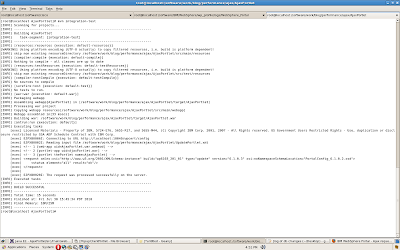I like to make my development environment as simple as possible and automate deployment so that i can test my changes rapidly. So i did create this very basic approach for automating deployment of portlet to WebSphere Portal using xmlaccess + maven. This approach is very similar to how you can automate deployment of portlet to Apache Pluto. You can download sample AjaxPortlet from here
I follow these steps whenever i create a new project
- I create a simple portlet.xml that does not have any id portlet application id like this
<?xml version="1.0" encoding="UTF-8"?>
<portlet-app xmlns="http://java.sun.com/xml/ns/portlet/portlet-app_2_0.xsd"
version="2.0" xmlns:xsi="http://www.w3.org/2001/XMLSchema-instance"
xsi:schemaLocation="http://java.sun.com/xml/ns/portlet/portlet-app_2_0.xsd
http://java.sun.com/xml/ns/portlet/portlet-app_2_0.xsd">
<portlet>
<portlet-name>AjaxPortlet</portlet-name>
<display-name>Ajax Portlet</display-name>
<portlet-class>com.webspherenotes.portlet.AjaxPortlet</portlet-class>
<expiration-cache>0</expiration-cache>
<supports>
<mime-type>text/html</mime-type>
<portlet-mode>view</portlet-mode>
</supports>
<portlet-info>
<title>Ajax Portlet</title>
<short-title>Ajax Portlet</short-title>
<keywords>Ajax Portlet</keywords>
</portlet-info>
</portlet>
</portlet-app>
The value of portlet-name is important for deployment - Then i create a pom.xml file which is build script for for my portlet and has custom integration-test target that i use for deploying portlet
<?xml version="1.0" encoding="UTF-8"?>
<project xmlns="http://maven.apache.org/POM/4.0.0"
xmlns:xsi="http://www.w3.org/2001/XMLSchema-instance"
xsi:schemaLocation="http://maven.apache.org/POM/4.0.0
http://maven.apache.org/maven-v4_0_0.xsd">
<!-- Change this to something akin to your java package structure -->
<groupId>com.webspherenotes.performance</groupId>
<modelVersion>4.0.0</modelVersion>
<!-- Version of this app -->
<version>1.0</version>
<!-- Base name of the war file without .war ext -->
<artifactId>AjaxPortlet</artifactId>
<packaging>war</packaging>
<name>${pom.artifactId}</name>
<!-- Dependency Version Properties ======================================= -->
<properties>
<portlet-api.version>2.0</portlet-api.version>
<servlet-api.version>2.4</servlet-api.version>
<jsp-api.version>2.0</jsp-api.version>
<wps.home>/software/IBM/WebSphere</wps.home>
<wps.url>http://localhost:10040/wpcert/config</wps.url>
<wps.admin.name>wasadmin</wps.admin.name>
<wps.admin.password>wasadmin</wps.admin.password>
<xmlaccess.path>/software/work/blog/performance/ajax/AjaxPortlet /UpdatePortlet.xml</xmlaccess.path>
</properties>
<dependencies>
<dependency>
<groupId>javax.portlet</groupId>
<artifactId>portlet-api</artifactId>
<version>${portlet-api.version}</version>
<scope>provided</scope><!-- Prevents addition to war file -->
</dependency>
<dependency>
<groupId>javax.servlet</groupId>
<artifactId>servlet-api</artifactId>
<version>${servlet-api.version}</version>
<scope>provided</scope>
</dependency>
</dependencies>
<build>
<finalName>${pom.name}</finalName>
<plugins>
<plugin>
<artifactId>maven-antrun-plugin</artifactId>
<executions>
<execution>
<phase>integration-test</phase>
<configuration>
<tasks>
<property environment="env"/>
<exec executable="/bin/bash" dir="${wps.home}/PortalServer/bin">
<arg line="xmlaccess.sh -user ${wps.admin.name} -password $
{wps.admin.password} -url ${wps.url} -in ${xmlaccess.path}"/>
</exec>
</tasks>
</configuration>
<goals>
<goal>run</goal>
</goals>
</execution>
</executions>
</plugin>
<plugin>
<groupId>org.apache.maven.plugins</groupId>
<artifactId>maven-compiler-plugin</artifactId>
<configuration>
<source>1.5</source>
<target>1.5</target>
</configuration>
</plugin>
</plugins>
</build>
</project>
In this file you will have to set properties for following things- wps.home: Location of portal installation base on your machine
- wps.url: Config URL for xmlaccess for your portal server it will be http://localhost:10040/wps/config by default
- wps.admin.name: User name for WPS admin
- wps.admin.password: Password for WPS admin
- xmlaccess.path: Path of UpdatePortlet.xml, which is a xmlaccess file that i use for deploying my portlets
In most of the cases when i create a new portlet only value that will change is xmlaccess.path to point to new updateportlet.xml which is already always in the same directory as that of pom.xml, i bet i can read that directory name using Apache Maven variable but i will have to get some time to find that out
In my script i have a integration-test target which makes use of ant to execute xmlaccess script that updates the portlet, this ant script gets executed when i execute mvn integration-test - The final step is to create a UpdatePortlet.xml file like this
<?xml version="1.0" encoding="UTF-8"?>
<request
xmlns:xsi="http://www.w3.org/2001/XMLSchema-instance"
xsi:noNamespaceSchemaLocation="PortalConfig_1.4.xsd"
type="update"
create-oids="true">
<!-- sample for updating a portlet from a new version of the WAR file -->
<portal action="locate">
<web-app action="update" active="true" uid="AjaxPortlet.war.webmod">
<url>file:////software/work/blog/performance/ajax/AjaxPortlet/target/AjaxPortlet.war</url>
<portlet-app action="update" active="true" uid="AjaxPortlet.war">
<portlet action="update" active="true" objectid="thePortlet" name="AjaxPortlet">
</portlet>
</portlet-app>
</web-app>
</portal>
</request>
The UpdatePortlet.xml file needs information such as location of .war file, PortletName that i can get portlet.xml, .war file name that i can get from pom.xml and once i change the updateportlet.xml to use correct values i am all set
Once my initial setup is in place i execute the mvn integration-test command to install the portlet for first time or update it, when i do that it take some time to build and then deploy it looks like this





















